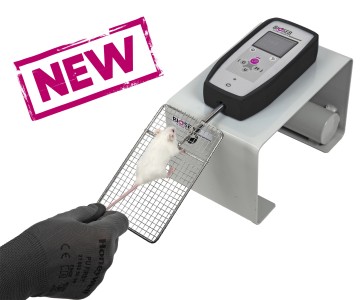Authors
A Kubota, M Juanola-Falgarona, V Emmanuele et al
Lab
Department of Neurology, Columbia University Medical Center, New York, USA
Journal
Human Molecular Genetics
Abstract
X-linked scapuloperoneal myopathy (X-SM), one of Four-and-a-half LIM 1 (FHL1) related diseases, is an adult-onset slowly progressive myopathy, often associated with cardiomyopathy. We previously generated a knock-in mouse model that has the same mutation (c.365 G > C, p.W122S) as human X-SM patients. The mutant male mouse developed late-onset slowly progressive myopathy without cardiomyopathy. In this study, we observed that heterozygous (Het) and homozygous (Homo) female mice did not show alterations of skeletal muscle function or histology. In contrast, 20-month-old mutant female mice showed signs of cardiomyopathy on echocardiograms with increased systolic diameter [wild-type (WT): 2.74 ± 0.22 mm, mean ± standard deviation (SD); Het: 3.13 ± 0.11 mm, P < 0.01; Homo: 3.08 ± 0.37 mm, P < 0.05) and lower fractional shortening (WT: 31.1 ± 4.4%, mean ± SD; Het: 22.7 ± 2.5%, P < 0.01; Homo: 22.4 ± 6.9%, P < 0.01]. Histological analysis of cardiac muscle revealed frequent extraordinarily large rectangular nuclei in mutant female mice that were also observed in human cardiac muscle from X-SM patients. Western blot demonstrated decreased Fhl1 protein levels in cardiac muscle, but not in skeletal muscle, of Homo mutant female mice. Proteomic analysis of cardiac muscle from 20-month-old Homo mutant female mice indicated abnormalities of the integrin signaling pathway (ISP) in association with cardiac dysfunction. The ISP dysregulation was further supported by altered levels of a subunit of the ISP downstream effectors Arpc1a in Fhl1 mutant mice and ARPC1A in X-SM patient muscles. This study reveals the first mouse model of FHL1-related cardiomyopathy and implicates ISP dysregulation in the pathogenesis of FHL1 myopathy.
BIOSEB Instruments Used
Grip strength test (BIO-GS3)
Source :

 Pain - Thermal Allodynia / Hyperalgesia
Pain - Thermal Allodynia / Hyperalgesia Pain - Spontaneous Pain - Postural Deficit
Pain - Spontaneous Pain - Postural Deficit Pain - Mechanical Allodynia / Hyperalgesia
Pain - Mechanical Allodynia / Hyperalgesia Learning/Memory - Attention - Addiction
Learning/Memory - Attention - Addiction Physiology & Respiratory Research
Physiology & Respiratory Research











![Dynamic Weight Bearing 2.0 – Postural Module [Add-on]](https://bioseb.com/733-home_default/dynamic-weight-bearing-20-add-on-postural-module.jpg)
























 Pain
Pain Central Nervous System (CNS)
Central Nervous System (CNS) Neurodegeneration
Neurodegeneration Sensory system
Sensory system Motor control
Motor control Mood Disorders
Mood Disorders Other disorders
Other disorders Muscular system
Muscular system Joints
Joints Metabolism
Metabolism Cross-disciplinary subjects
Cross-disciplinary subjects CONFERENCES & MEETINGS
CONFERENCES & MEETINGS 